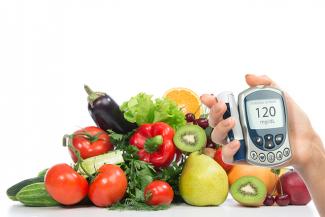
Can a person with diabetes eat fruit? Which fruits and how much? Can they eat nuts? Dietitian and Diabetes educator Ujjwala Baxi has all the answers.
Fruits are healthy, but even healthy individuals cannot binge on fruits. Excessive fruit intake has shown to have negative implications on triglycerides (a type of lipid detected in the blood lipids profile test). A healthy, active individual can have 4-5 servings of fruit a day, which is 500g of fruit.
अब हिन्दी में पढ़ें: डायबीटीज़ में फल और नट्स (बादाम आदि) के सेवन के बारे में जानें
People with diabetes need to be extra cautious about their fruits servings. They need to consume fruits in moderation as they are easily prone to developing heart disease. While fruits are high in vitamins and minerals, they are also rich in carbohydrates, which, if eaten in large amounts (more than 5 servings of fruits in the form of fruit juices, fruit plates) increase blood sugar, which ultimately gets stored as triglycerides.
Individuals with diabetes can eat fruits, unless specifically advised against it by their doctor. But they need to limit their portions.
Here are some Frequently Asked Questions by our PatientsEngage members, and my responses.
As a diabetic, I have been told to have fruits but in limited quantity. What does “limited quantity” mean?
People with diabetes can consume 2 – 4 servings a day based on their blood sugar profile. Try to have one serving at a time.
1 serving of various fruits is as follows:
- 1/2 banana
- 1 small apple, orange, or pear
- 1/2 cup chopped, cooked or canned fruit (without sugar syrup)
- ½ cup berries
- 2 medium slices of large fruits like papaya, watermelon, and pineapple
You can mix and match fruits to get a variety of minerals and vitamins while keeping within your advised servings recommendation. Check your blood sugars regularly to understand how different fruits are impacting the level.
In India and some Asian countries, fruits like guava, papaya, banana, watermelon, orange, apple, grapes are available almost throughout the year. So what fruits are taboo and what are not and how much of these can be consumed by people with diabetes?
In my opinion, people with diabetes are just like other healthy individuals and should enjoy all fruits, especially those in season. However, the key is moderation and eating the recommended number of servings only. Yes, some patients may need to strictly avoid some fruits if any diabetes related complications exist.
Most of us know that mangoes, chickoos, even very sweet bananas are not recommended for people with diabetes. Does that mean that we cannot enjoy these as an occasional treat?
Even Adam could not refrain from tasting the forbidden apple… It’s human to crave and like these delicious fruits. Mangoes, bananas and chickoos are high in natural sugar, and a person with diabetes may reward himself with a few slices once in a while when the blood sugars are within the favourable range. The idea is to maintain your blood sugar level as close as possible to normal, so you can enjoy nature’s delicacies occasionally.
Berries are said to be healthy, but in India and Asian countries, they are not easily available and are either expensive or of poor quality. Can you tell us some healthy alternatives?
Berries like strawberries and blueberries have their own charm and are rich in antioxidants and Vitamin C. But you can try pomegranates, peaches, goose berries. These are good alternatives and bear a similar nutrition profile. 3 goose berries or 1 whole medium-sized pomegranate can be considered as 1 serving.
What nuts are good and in what portions? Are peanuts taboo for diabetics?
All nuts are good for health and have distinctive nutrition profiles. In fact if you eat nuts along with high-glycaemic index foods, such as pesto pasta, this could potentially slow absorption of carbohydrate, stabilising blood glucose levels. Nuts have magnesium, which is generally found to be low in most indivisuals. You can have a handful of nuts in a day. But remember, it is easy to go overboard munching on nuts as they feel so good and crunchy in the mouth.
Some Asian cuisines, like Maharashtrian and South Indian cuisines or Indonesian cuisine are high in peanuts and hence it may be best to stay off these as limits may be exceeded. If you are not used to consuming nuts, try a handful of boiled peanuts to start with.
Ideally I would advise a personal consultation over fruit consumption and see the overall blood sugar response. Self-Monitoring of Blood Glucose can help you understand how much fruit to eat and when to eat it. Point to be noted: Fruits when consumed with meals tend to reflect high in 2 hours post prandial blood sugar check.
Related Article: Do's and Don'ts of Diabetic Diet






